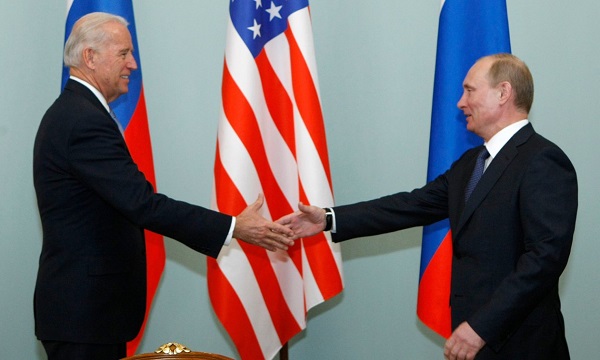
New START Treaty
Overview:
| New START Treaty Signed on: | 8 April 2010 in Prague, Czech Republic. |
| Signatories: | 2 Signatories. |
| New START Treaty Effective from: | 5 February 2011. |
| Agreement Type: | Bilateral Agreement. |
| New START Treaty Area: | Offensive Arms agreement. |
What is New START Treaty?
The New START Treaty is the treaty between the United States of America and the Russian Federation on Measures for the Further Reduction and Limitation of Strategic Offensive Arms, which includes intercontinental ballistic missiles (ICBMs), submarine-launched ballistic missiles (SLBMs), and heavy bombers equipped with nuclear armaments.
On 21 February 2023, Russia suspended its participation in New START treaty meetings. Russia clarified that it will not withdraw from the treaty and continue to abide by the limits of the treaty.
New START Treaty Signed:
The treaty was signed on 8 April 2010 in Prague, Czech Republic and entered into force on 5 February 2011. In February 2021 the United States and the Russian Federation agreed to extend the treaty till 4th February 2026.
Signatories:
The signatories of the New START Treaty are the United States of America and the Russian Federation.
Objectives:
The New START Treaty enhances the national security of both countries U.S. and Russia, by placing verifiable limits on all Russian and U.S. deployed intercontinental-range nuclear weapons.
Treaty Duration:
The treaty’s original duration was 10 years until February 5, 2021, with the option for the Parties to agree to extend it for up to an additional five years.
The United States and Russian Federation agreed on a five-year extension of the New START treaty to keep it in force through February 4, 2026. The treaty includes a withdrawal clause that is standard in arms control agreements.
Strategic Offensive Central Limits:
Under the treaty, the United States and the Russian Federation had seven years to meet the treaty’s central limits on strategic offensive arms by February 5, 2018, and are then obligated to maintain those limits for as long as the treaty remains in force.
Verification and Transparency:
The treaty contains detailed procedures for the implementation and verification of the central limits on strategic offensive arms and all treaty obligations. New START Treaty Verification Measures are-
Onsite Inspections: The treaty provides for 18 on-site inspections per year for U.S. and Russian inspection teams.
Warheads Loaded on Specific Strategic Delivery Vehicles: During inspections of deployed strategic weapon bases/facilities, each side must disclose how many warheads are on each delivery vehicle-based at the inspected base, and the inspecting country has the right to inspect the loading on one delivery vehicle (chosen by the inspecting country) to confirm the declaration is accurate.
Biannual Data Exchanges: Each country provides the other with a declaration of its deployed strategic delivery vehicles, launchers and warheads. A substantial amount of information is also provided in the periods between biannual exchanges, via treaty-required notifications.
Telemetric Information: To enhance transparency, the Parties annually exchange telemetric information on a parity basis, for up to five ICBM and SLBM launches per year. These measurements of various technical parameters are made to monitor missile performance during ICBM and SLBM flight tests.
Strategic Delivery Vehicle and Launcher Notifications: The treaty provides for rolling notifications regarding the status and basing or facility assignment of all strategic delivery vehicles and launchers.
New Types, New Variants, and New Kinds of Treaty‑Accountable Systems: Declaration and exhibition of new types and new variants of treaty‑accountable systems that enter service. The system would then be subject to data declarations, notifications, and inspections under the treaty.
Bilateral Consultative Commission: The treaty establishes the BCC (Bilateral Consultative Commission) as a compliance and implementation body that meets at least twice each year unless otherwise agreed. Compliance or implementation questions may be raised by either Party in the BCC.
Ballistic Missile Launches: The treaty provides for pre‑launch notifications of the launch of treaty‑accountable ballistic missiles.
Non‑Interference with National Technical Means (NTM): The treaty permits the use of national technical means of verification in a manner consistent with international law.
Unique Identifiers: Each ICBM, SLBM, and heavy bomber is assigned a unique identifier, which is included in the applicable notifications and may be confirmed during inspections.
Data Exchanges and Notifications:
Each side exchange data on the numbers, locations, and technical characteristics of weapons systems and facilities that are subject to the treaty and provides each other with regular notifications and updates. Types of information exchanged under the New START Treaty are-
New missiles entering the force: Each party provides 48 hours' notice before a solid-fueled ICBM leaves a production facility.
Basing location of treaty-accountable missiles: Each party provides notification of its associated base or facility.
The status change for missiles: Each party provides notification when missiles become deployed or non‑deployed and sent to declared facilities.
Advance Notice of Major Strategic Exercises: Each party provides notification at least 2 weeks prior to a major strategic exercise involving heavy bombers and notifies again within 2 days following the exercise’s conclusion.
Elimination and conversion: Notification of the elimination of treaty‑accountable systems or conversion to non‑nuclear or non‑accountable status.
Implementation of Treaty:
The information provided through the treaty’s implementation contributes to reducing the risk of strategic surprise, mistrust, and miscalculations that can result from excessive secrecy or decisions based on worst-case assumptions.
‘Type One’ and ‘Type Two’ Inspections:
The New START Treaty provides for 18 on-site inspections per year. There are two basic types of inspections. Type One inspections focus on sites with deployed and non-deployed strategic systems, and Type Two inspections focus on sites with only non-deployed strategic systems. Each side is allowed to conduct ten Type One inspections and eight Type Two inspections annually.
Official languages:
The official languages of the treaty are English and Russian.